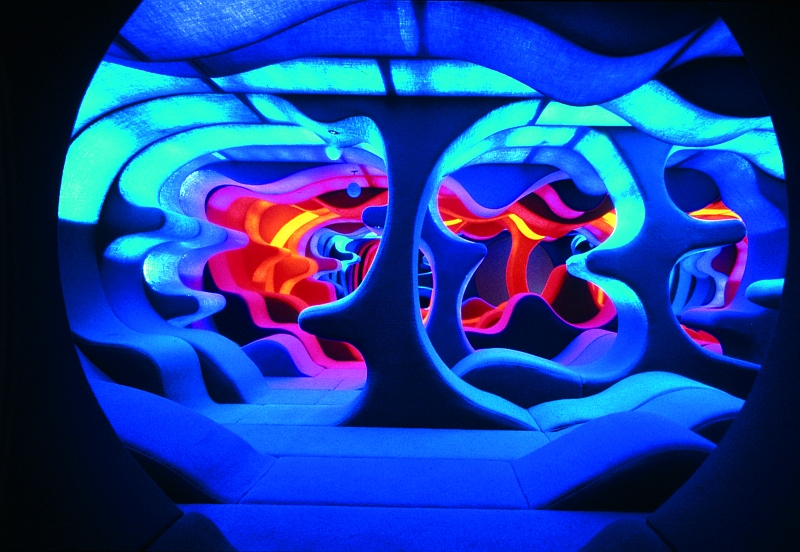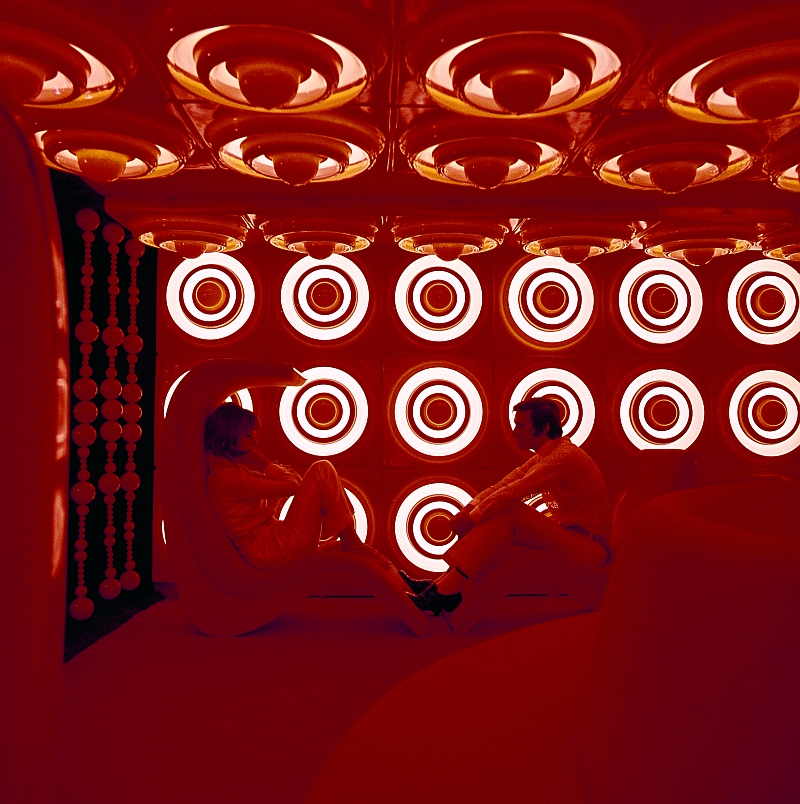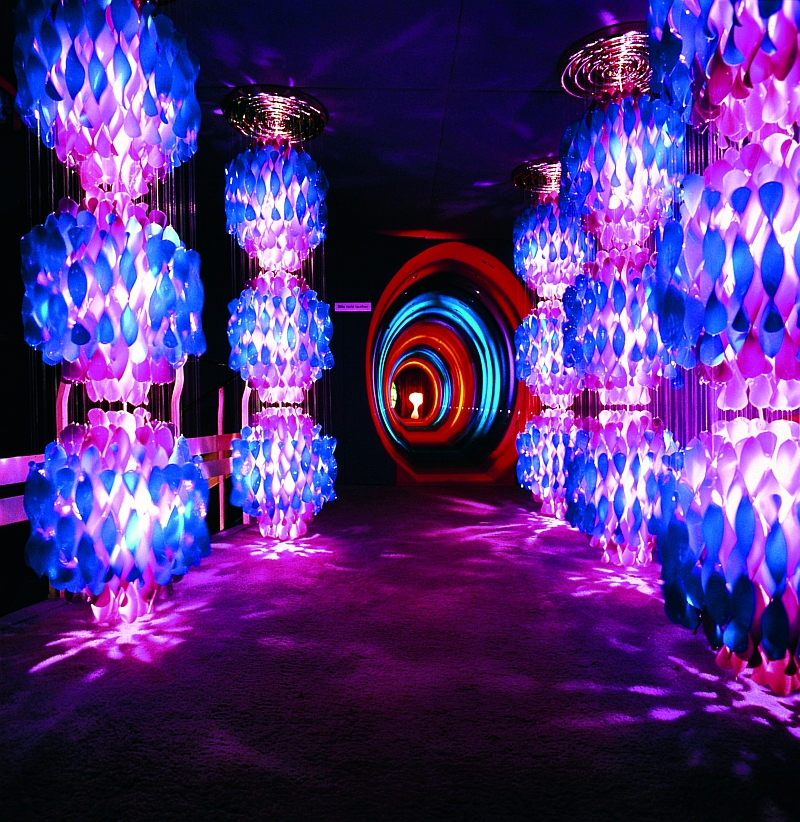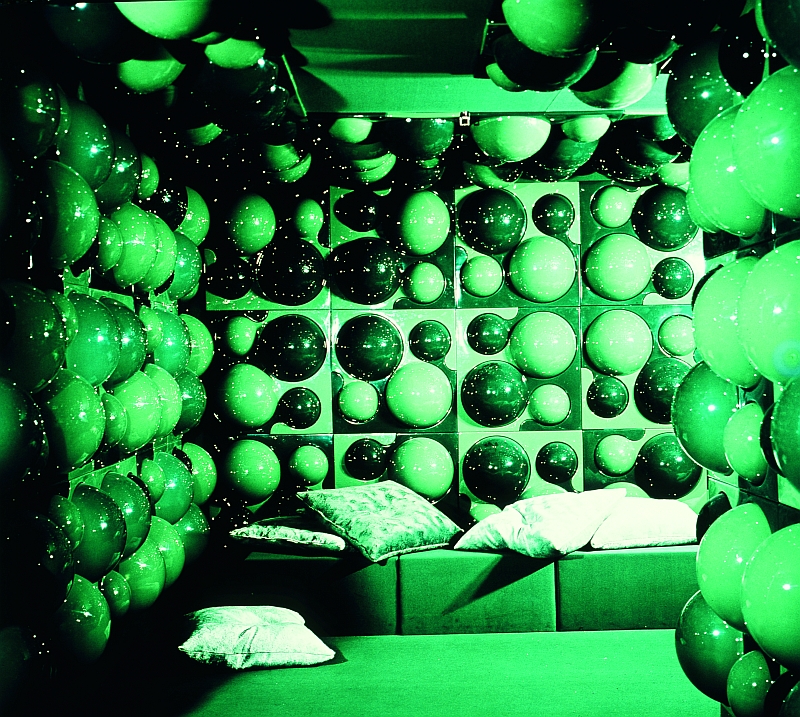(smow) blog Design Calendar: 25th January 1970 – Visiona 2 by Verner Panton Opens in Cologne
“Wood will be driven out of living spaces; even metal and glass, although much newer in domestic situations, are losing their importance. Plastics are on the advance…..”1
What had caused the German magazine Stern to pronounce in February 1970 so unequivocally on the future of home furnishings?
Stern had seen Verner Panton’s Visiona 2 exhibition at Cologne Furniture Fair. And knew it had seen the future.
“It is certain that a new age is rolling through our homes. What is coming is not just a change, rather the definitive break with a thousand years of habit”
Boah!
The 12th Cologne Furniture Fair opened on January 25th 1970 and presented the latest products from 1200 exhibitors from 26 nations to over 78,000 visitors2; the media highlight of Cologne 1970 however was without question Verner Panton’s Visiona 2 showcase realised in conjunction with the chemicals conglomerate Bayer and presented on a ship moored next to the main exhibition centre. Or in the words of Carol Clarke writing in Architectural Design “The Bayer Company upstaged the Cologne Furniture Fair this year with a new interior treatment for their Rhein boat.”3
Initiated in 1968 as a showcase for Bayer’s collection of modern, synthetic fabrics, Visiona was conceived as an annual exhibition series to be curated by a different international architect/designer/interior designer and in which the curator was given the freedom to present their, textile heavy, vision of the future.
Verner Panton had been responsible for the first Visiona, and the fact that Bayer had approached Panton was of course no chance event. Verner Panton had established something of a reputation.
His 1958 Cone Chair not only reshaped the accepted form of the chair, and by extrapolation preconceptions as to what a chair could/should be, but with its somewhat risqué presentation in the Danish magazine Mobilia, reshaped the accepted aesthetic of furniture advertising. In 1960 he combined the Cone Chair with his Geometri textile in his design for the Hotel Astoria in Trondheim, to create rooms just as mesmerising if less physically imposing than those later presented at Visiona; and in the same year the Danish manufacturer Plus-linje released Panton’s inflatable plastic stool, the first piece of transparent, inflatable plastic furniture – and a full seven years before Zanotta released Paolo Lomazzi, Donato D’Urbino and Jonathan De Pas’ inflatable armchair “Blow”. In 1965 Verner Panton wowed Cologne with his flying chair concept before in 1967 the, arguably, defining moment in Verner Panton’s career was reached when Vitra released the eponymous Panton Chair; a product that so violently altered what we understood about furniture that although initially only produced until 1979, its influence remains unbroken to this today.
Panton’s Pop Art heavy 1968 showcase took the Visiona concept further than Bayer had intended and while he did devote part of the space to a presentation of Bayer’s fabrics, through the integration of lighting and furniture he transformed the majority of the ship into a fundamental exploration of the future of the domestic space. The Italian architect Joe Colombo continued and expanded on this theme for his 1969 Visiona 1 exhibition before the concept reached its zenith with Panton’s Visiona 2.
A 3D collage of light, colour, sound and smell, Visiona 2 was unquestionably much more about Verner Panton’s vision for the future of architecture than it was about Bayer’s fabrics.
In a 1967 interview with Stern Verner Panton had expounded his vision of a future in which houses are constructed from variable modules created in a single mould, which would roll from conveyor belts and come equipped with, amongst other features, “rooms specially for watching television in which the viewer sits in the middle of the production. The images projected on to the walls, roof and floor”4 A central feature of Verner Panton’s vision of the future was colour, “The background colour of the rooms will be silver or white. Despite this the spaces will be colourful, as the neutral background will be enlivened by light generated colours. This will improve the well-being of the residents; colours having an important, positive, psychological effect.”5
Many of these ideas could be found in Visiona 2. Walking through the three exhibition floors the visitor was taken not only on a journey through a series of function specific spaces but through a landscape of carefully considered, contrasting, colours, forms and textures, “the space is totally fabric wrapped, with no distinction between floors, walls or ceiling”, Carol Clarke informs us, “shapes grow out of this cocoon to form body supports, fish tanks, lighting etc.”6
Indeed watching videos of the Visiona 2 exhibition is a bit like watching the original 1973 version of the film The Wicker Man, the movement, sound and light draw you, unwittingly, against your will and better judgement, into a psychotic, pseudo-erotic madness: a situation that certainly helps explain the outpouring of euphoria from Stern.
Majestic as his composition unquestionably is and was, Verner Panton’s return to the Visiona platform in 1970 is also possibly the best indication that despite the rampant hype around the new “space age” furnishings of the late 60s/early 70s, apart from Panton and Colombo there was dearth of talents able to competently articulate such a vision. And more importantly a lack of consumers looking to purchase such. Despite the media hype. Media hype famously never equalling commercial success. Despite what the media think.
Cologne 1970 also included, for example, Bulthaup’s Typ 1 kitchen, an ensemble that resembles the bridge of the USS Enterprise and which in wonderful, almost poetic, juxtaposition to the culinary temples Bulthaup offers today, was intended only as a hub for heating ready-meals; or Luigi Colani’s “Experiment 70” kitchen for Poggenpohl that similarly predicted a future in which preparation of meals was unnecessary and in which the kitchen was demoted to a sort of domestic command control centre.
But from these and similar projects nothing remains.
Similarly from the objects Verner Panton designed for Visiona 2 only the Amoebe chair, Cloverleaf sofa and the Spiral, Ball and VP-Globe lamps are currently in production.
Much of Panton’s vision has however survived, albeit in a more matt version. And with a lot more wood, metal and glass than could be found in Stern’s pulsating fantasy.
For Verner Panton Visiona 2 was essentially about presenting the home as a location where one could escape the stress and strains of an increasingly achievement-orientated society, the home no longer principally as a passive domicile but as an active location for relaxation and recreation, a private refuge where the modern world with all its innovation and progress was employed for the benefit of the individual rather than for economic advantage.
Which of course makes it a shame that he didn’t foresee the internet. Imagine a fully networked Visiona 2!
In many respects one can also see in Visiona 2 the origins of research into the concept of “Rooms within Rooms”, of a greater flexibility in interior architecture to allow optimal use of the available space: a concept which has only recently reached full maturity, and popular acceptance.
Were not saying that without Visiona 2 we wouldn’t have reached our current understanding of domestic architecture and furnishings: but the path would have stonier and somewhat more arduous.
Consequently amid all the hype perhaps Panton’s real intentions with Visiona 2 can be best summed up by his statement that “One can describe such experiments as utopic, but they help us to expand our experience. And that is what it is all about”7
Which of course brings us back to Fritz Haller, his Space Colony and Dr. Georg Vrachliotis’ contention that “… in principle Fritz Haller went to space to be able to think better about earth.” Verner Panton vanished into a garish Alice in Wonderland hell cave to help us better understand the new possibilities for domestic harmony that awaited us.
1 Stern Nr. 8 15th February 1970
2 “Das Möbel kommt in die Dimension des Konsums” Form 49 March 1970
3 Carol Clarke, “Panton at Cologne”, A.D. Architectural Design May 1970
4 Stern Nr. 30 23rd July 1967
5 ibid
6 Carol Clarke, “Panton at Cologne”, A.D. Architectural Design May 1970
7 Stern Nr. 8 15th February 1970
Tagged with: amoebe, Ball Lamp, cologne, imm cologne, Spiral Lamp, Verner Panton, Verpan, Vitra, VP-Globe lamp



